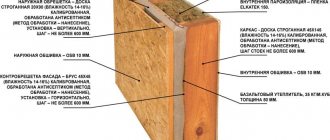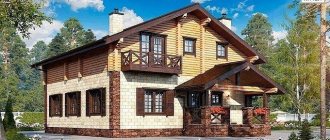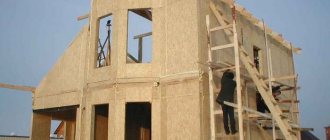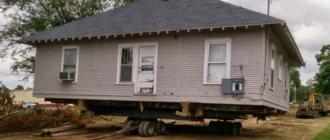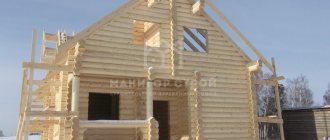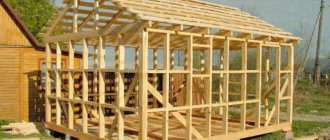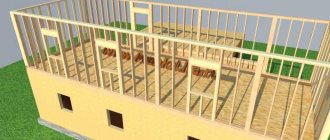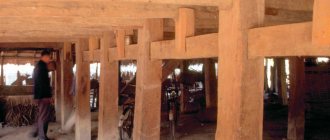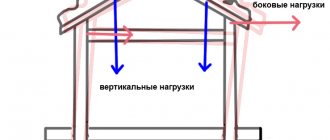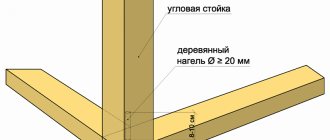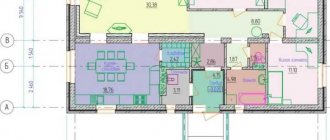Everyone who hears about winter construction of a frame house for the first time experiences some surprise and even distrust of this method of constructing a residential building. Is it possible to build a frame house in winter? Few people know that a frame house consists of materials that are practically not subject to negative influence from environmental conditions, and therefore construction can be carried out in absolutely any season of the year.
Today we will stop and look at the construction of a frame house in winter, we will talk about the possible benefits, features and disadvantages of such construction.
We build a frame building in winter
Are frame houses built in winter and will such construction be very different from construction in the warm season? There are factors to consider when building a frame house in winter conditions.
A building in the forest built in winter.
Foundation
It is possible to build a light foundation in the winter season. However, if the design provides for a monolithic foundation of increased strength, it is better to think about its construction in the summer or early autumn. Warm weather conditions are required for the concrete foundation to fully harden.
Frame
A frame house in winter is made from materials that do not react in any way to prolonged contact with snow. At the same time, during winter construction, wood does not need to be treated with antiseptic agents; frost will save on expensive chemical treatments.
Finishing work
During winter construction, the customer can begin finishing work on the building in the spring, and in the summer they can easily move into their new frame house.
Heating of frame houses
It should be noted that a frame house cools much faster in winter than a stone or wooden one. However, the disadvantage is compensated by the fact that warming up takes much less time. According to reviews from builders and owners of frame houses, a cooled frame house of a small area can become warm again in just a few hours.
Heating a frame house is quick and economical when compared with stone or brick buildings, which, when cooled down (if the outside temperature is around 20 degrees), can warm up for several days. A house on two floors, measuring 6 by 8 meters and built using frame technology, is heated by two 2 kW electric heaters in just three hours. With the same initial data, a log house will warm up for about a day. And it is generally not recommended to expose brick houses to sudden changes in temperature.
Thus, it is possible to use a frame house in winter, as evidenced by numerous reviews from construction industry specialists. And if there is a good ventilation system and a heat accumulator, even more so. It is recommended to maintain the temperature inside the building by periodically heating it, which will allow the heating radiators to release heat evenly. Moreover, good thermal insulation of SIP panels will save energy spent on heating.
Insulation in winter
Is it possible to insulate a frame house in winter? Installation of insulation is carried out according to a well-known scheme: a vapor barrier film is laid on the inside of the frame house, then comes the insulation itself, then follows a windproof membrane, which will not allow cold air from the street to enter the room.
Frame house made of SIP panels.
In this case, the wall pie of the frame house must be thick enough to prevent freezing and then heat loss will be minimized. The thickness of a frame house for winter includes, first of all, insulation, which is selected depending on the climate zone and the maximum negative air temperature.
In order to efficiently insulate a frame house in winter, you can safely use building materials that are used during summer construction. To insulate the vertical surfaces of the frame, you can use mineral wool or basalt mats. If you plan to save on the construction process, the same materials can be used for laying the ceiling, roof and between floors.
If the design of the house includes a basement floor, insulation can be done using polystyrene foam boards. The thickness of the slab must be more than 250 mm.
When building a frame-panel house, you don’t have to think about insulation, since it is already included in the panels produced in the factory. Floor insulation is often done using SIP panels. The materials are produced in a factory and represent a multi-layer “pie”. It is enough to simply lay the slabs on the floor and not worry about additional insulation.
Selecting insulation for a frame house and its installation
The choice of materials for building a house should be approached with care; special attention should be paid to insulation. In particular, in addition to the main function of thermal protection, it must have such properties as fire resistance, moisture resistance, environmental friendliness, high noise insulation and long service life. The thermal insulation material must be ideally combined with the base of the frame.
Review of materials
Mineral wool fully meets all these requirements ; it is one of the most popular and economical insulation materials for a warm frame house. When insulating a house from the inside with mineral wool, you can simultaneously solve the problem of sound insulation.
Several types of mineral wool are used as insulation:
- glass wool;
- slag;
- stone or basalt wool.
Each of these materials has different properties and also has its own pros and cons.
Glass wool is an economical, very strong and elastic material obtained from glass production waste. One of the oldest types of insulation. It has high thermal conductivity, vapor permeability, resistance to parasites and a high noise absorption coefficient. Withstands temperatures up to plus 500 and minus 60 degrees.
One of the main disadvantages of working with glass wool is that it is quite fragile, poses a danger to the eyes and mucous membranes of builders, and requires special care and the use of protective equipment during installation.
Slag wool – the raw material for this material is blast furnace slag processed into microfibers. The advantage of using slag wool as insulation is its high thermal efficiency.
Slag wool is resistant to parasites and does not burn. The material is highly fragile and requires the use of respiratory, vision and skin protection during operation. It easily absorbs water, so it needs good waterproofing. May contain a small amount of phenol formaldehyde.
Basalt wool - its fibers are environmentally friendly and are not brittle, therefore they are not dangerous for builders. Withstands a temperature range from plus 1000 to minus 190 degrees, does not burn, but only melts at high temperatures. Does not absorb water, allows steam to pass through well, and has excellent thermal conductivity. Available in rolls, easy to cut and stack. But it costs more than the above types of cotton wool.
Useful: Adding a veranda to the house
For external insulation, experts recommend using glass wool or basalt wool, and for internal insulation, in addition to the previous two types of insulation, slag wool.
There are other types of insulation : foam plastic, penoplex, expanded clay, sawdust. However, they are significantly inferior to mineral wool in terms of efficiency, durability and thermal conductivity. And often they cost an order of magnitude more.
Insulation technology
One of the requirements when working with mineral wool is a relative air humidity of no more than 85% at a temperature no higher than +30 °C and no lower than – 10 °C. A prerequisite for maintaining heat in the house is the correct installation of insulation; it should lie tightly, but should not be allowed to be firmly pressed between the frame posts.
It is necessary to use windproof and vapor barrier films and make good waterproofing using waterproofing agents. At the request of the customer and for greater thermal insulation, it is possible to increase the layers of wool.
Heating
When organizing a heating system during construction in winter, be sure to complete all work on installing the frame, walls and insulating the structure. Installing a heating system in an unfinished house can result in freezing of pipes and other problems that will negatively affect the operation of the heating in the future. The heating of a frame house in winter is arranged in such a way as to eliminate as much as possible the possible escape of thermal energy to the street.
Do-it-yourself warm floor.
Is it possible to live in a frame house in winter? If you organize the correct heating system, ensure insulation of all seams and timely removal of snow, it will be comfortable in a frame building. Such frame structures are quite common in Scandinavian countries, so we can definitely say that the house is suitable for year-round use.
It is better to give preference to a combined heating system, which consists of several components. So, you can use a solid fuel boiler that will heat the room in the evening, an electric boiler and heated floors for heating at night, and special solar panels to generate heat during the day.
Reviews
Igor, 37 years old: “My frame heats up very quickly, but does not consume much energy. I heated my two-story house, measuring 6*8 meters, from -27 to +26 degrees in a little over three hours, and heated it with a pair of two-kilowatt heaters. A neighbor's log house of a similar size heats up for 24 hours under the same conditions. But stone houses take longer to heat up or require a powerful heating system. By the way, this regime of sudden heating and cooling is extremely harmful for a stone house, and it also damages the masonry, i.e. a house lives much less than a frame house.”
Dimitri, 26 years old: “Thermal capacity is extremely important for regular heating. My wife and I are planning excellent heating that is not like the conventional one. It turns out that this is a boiler or stove, which is also heated once a day (or 2, if the frosts are very severe). But the presence of a heat accumulator and simple automation makes it possible to transfer the operating principle of heating to a constant mode. Even despite constant heating, the radiators in the house will evenly release heat throughout the day.”
Marat, 30 years old: “There is a concept of thermal inertia of a building, and at the moment, with the constant increase in the cost of energy carriers and fuel, such a concept is extremely relevant. In the American states, you can safely live in a house built from sandwich panels made from a pair of plywood and 12 cm of insulating material between them. Electricity costs pennies, air conditioning is not a luxury. In my house, everything is not like that - in a frame house with high quality insulation it is comfortable as long as the stove is working. Once it cools down, that’s it; after an hour the temperature will drop sharply. And using electric heaters is expensive.”
Alexander, 49 years old : “I live in a two-story frame house, the heating is a brick oven. The house is covered with boards on the outside and clapboard on the inside. As insulation, I use foam plastic with a thickness of 10 cm, and if you heat the stove a couple of times a day (the temperature outside is -15 degrees), the temperature difference between the fireboxes will be no more than 6 degrees. Approximately on the fifth day of daily heating, the humidity inside the room will be the same as in a city apartment with simple heating. You will need to raise the humidity a little. Thermal inertia in the house is noticeable, and if you heat a cooled, cool house, then the house will be +26 and above after 4-5 fires. If you live in a house and heat it constantly, then everything will be fine, convenient and inexpensive.”
Vitaly, 34 years old : “By the way, about the temperature level in housing - in the house it should be thermal inertia and this will compensate for changes in external temperatures without the use of additional energy. This is achieved due to the accumulated energy, which will ensure the maintenance of the temperature level and structural humidity. Inertia-free systems using polystyrene foam will also not accumulate anything, which will ensure warm-up speed. But they also do not store heat, which is necessary to constantly maintain energy levels. But it will not just be a matter of temperature, and in this case the problem was solved by means of a thermal regulator. Don’t forget about humidity, and as a result, there must be a system of ventilation and heating. If there are no problems with finances, then you can live inside a frame structure without any problems. This is what they do in America, where incomes are high and electricity is inexpensive.”
Can be built in winter
Building a frame house in winter will be beneficial in many ways; today we will talk about five main factors that will help you make a choice in favor of frame construction in winter.
Cost of lumber
In winter, many building materials, including lumber, significantly lose value. It is during the winter period of the year that you can find the most attractive price offers on the market. It is worth noting that winter wood is considered to be of higher quality than summer wood, this is due to the fact that during drying there is practically no deformation or shrinkage of the material.
Building with an attic in winter.
Winter wood is characterized by a small number of cracks, in which pests do not develop in the future.
Cost of construction work
It is often cheaper to build a frame house in winter than in summer. This is due to a decrease in demand for construction services. Many companies offer clients a fixed construction cost during the winter season.
The tree does not need to be antiseptic
We build a frame house in winter and boldly refuse expensive chemicals that are used to treat wood to protect against pests and fungus. The fact is that frost is considered a natural antiseptic. In the winter season, truly eco-friendly houses are obtained.
No rain and mud
Snow allows building materials to remain clean during transportation and storage. The wood used for the construction of frame houses practically does not absorb moisture from snow. So, if during heavy rain in the summer the construction process will have to be postponed indefinitely, then during snowfall it is enough to clear the construction site of rubble and calmly continue further construction.
More control for builders
Because of prejudices, frame houses are built much less often in winter. You can build a frame house in winter and count on increased attention to the project from the builders. The team is in no hurry to finish the work as quickly as possible in order to begin the new project. The construction process is carried out with higher quality, with maximum control on the part of the contractor.
We build in cold weather.
Is it possible to live in a frame house in winter: heat loss, reviews, characteristics
Frame house - is it possible to live in it in winter? For most of us, the concept of “frame house” is unknown, and if anyone has heard of it, they are unlikely to be able to clearly explain this type of housing.
History of frame construction
The technology for building such housing has existed since the mid-20th century. And it began in the USA and Canada, where 75% of low-rise housing is made up of frame houses. Beginning in 1945, the flow of emigrants to Canada increased, and in the United States that time coincided with the return of soldiers from the front. These factors have sharply increased the demand for housing. It was necessary to build quickly, inexpensively and in large quantities. Thanks to these requirements, the technology of building frame houses was born. By the way, it is worth noting that the climatic conditions in Canada are similar to those in Ukraine, which means frame construction is 100% suitable in our country.
The principle of frame construction
This technology has the following features: its functions are divided into enclosing and load-bearing. The load-bearing function of the structure is taken over by a wooden frame, and the fencing is made of sandwich panels made of plywood and various insulation materials. A frame house is the same full-fledged dwelling as a house made of red or sand-lime brick, the same as a house made of foam and aerated concrete.
Features of a frame house
But at the same time, a frame house has undeniable advantages compared to houses made of stone and brick, such as:
• fast pace of construction and low cost;
• lightness of the structure eliminates the need to lay a massive foundation, which in turn eliminates settlement of the house
• the absence of “wet” processes during the installation of a frame house ensures all-season finishing;
• the use of fireproof materials during construction ensures high fire safety;
• and finally, frame houses have low thermal conductivity of the walls and high thermal protection.
If everything is relatively clear with the first points, then with the last one people are often subject to doubts - “Is it possible to live in a frame house in winter?” “Is it expensive to heat this type of home?”
Conditions for winter living in a frame house
It is absolutely comfortable and convenient to live in a frame house at any time of the year, including winter. Heat losses in a frame house are lower than in a house made of stone or brick, but the energy and time required to warm up the house is much less than for a stone house - a frame house quickly warms up due to the small heat capacity of the walls.
By the way, in summer it cools down just as quickly and you don’t have to swelter from the heat on a July afternoon.
Frame housing is rightfully considered to be quite warm of all inexpensive types of housing that currently exist.
We use quality material
This is ensured through the use of high-quality materials and the correct technology for thermal insulation of floors and walls. By the way, the small thickness of the wall of a frame house using sandwich panel technology provides the same thermal insulation properties as a 2-meter thick brick wall!
Correct windows and doors
Naturally, in addition to high-quality thermal insulation of walls and ceilings, one should not forget about good doors, windows and their professional installation. Thus, using the services of construction companies with extensive experience in the construction of frame houses, you will receive a high-quality house in the shortest possible time, which will provide you with comfortable living conditions, both in the summer heat and in the winter frosts. But, unfortunately, not a single barrel of honey is complete without a fly in the ointment... We'll talk about this below.
Is a frame house an ideal option only for a summer residence?
No matter how excellent a frame house is, this type of housing is most suitable for a country house option. This type of home requires constant temperature maintenance and normal ventilation, which requires higher heating costs compared to other types of houses. A frame house, of course, cools down faster than a stone or wooden one, but it also warms up faster.
Attention! A cold frame house can warm up to + 25 degrees from several hours to one day, depending on its area and heating methods.
But in any case, the heating process is faster and more economical compared to heating houses of other types. Since country housing is not the main one, the most powerful argument when choosing the type of country house will be its cost. And here the frame house confidently outperforms competitors with a low cost and high construction rates. It is worth adding that today there are a huge number of projects of houses of this type, from classic rustic style to ultra-modern.
Attention! Many construction companies provide the customer with a choice from a large number of projects completely free of charge.
Summarizing
Are frame houses warm? It is quite difficult to assert this based on facts.
Frame housing does not have many disadvantages:
- fast cooling;
- relatively high heating costs.
Considering these factors, the financial capabilities and mentality of our citizens, who love everything large, durable and solid and not expensive to maintain, not everyone will choose a frame house for their main home. But as a holiday home, a frame house has no competitors in all respects: construction time, cost and appearance of the home. We tried to briefly tell you about all the features of frame construction, and the final choice is yours.
Reviews we collected about frame houses
Michael:
The house warms up quickly enough and does not consume too much energy. I warmed up my two-story frame house, 6 by 8 m, from -25 to +25 for a little more than 3 hours. I warmed it up with two 2 kW heaters.
A neighbor’s house made of timber of the same size takes 24 hours to warm up. Heating of the same power.
But a stone house will take much longer to warm up, or you need to use more powerful heaters. By the way, this regime of sudden heating and cooling is very harmful for stone houses; it spoils the masonry, which means that such a house will last less than a frame house.
Egor:
Heat capacity is very important in intermittent heating. We are planning heating that is different from the generally accepted one. That is, this is also a stove or boiler, it is also heated once a day (or 2 in severe frosts). But the presence of a VTA (heat accumulator) and simple automation makes it possible to transfer the operating principle of the heating system to constant mode. That is, despite periodic heating, the batteries in the house evenly release heat throughout the day.
Dmitriy:
There is such a thing as thermal inertia of a building. And at the present time of constant rise in prices for fuel and energy resources, this concept is very relevant. In non-northern American states, you can live in a house made of sandwich panels made of 2 plywood and 120 mm of insulation between them. Electricity costs pennies there, and air conditioning is not a luxury. With us everything is a little different. A frame house with high-quality insulation is comfortable while the stove is working. As soon as it cools down, that’s it, after an hour the temperature drops sharply. But using electric heaters is a bit expensive...
Sergey:
I live in a frame house, 2 floors. I heat using a brick stove. The outside of the house is covered with boards, and the inside is clapboard. The insulation is polystyrene foam (thickness 100 mm). If you heat the stove 2 times a day (the temperature outside is minus 10-15 degrees), the temperature difference between the fireboxes is no more than 6 degrees Celsius (the norm is 8 degrees). On approximately the 5th day of daily heating, the humidity in the room becomes the same as in a city apartment with conventional heating. You have to raise the humidity a little. The inertia of heat in the house is felt. If you warm up a cooled, cold house, then + 25 or higher in the house is reached the next day after about 4 or 5 fires. If you live in a house and heat it constantly, everything is fine - warm, comfortable and not expensive.
Vladimir:
Speaking of temperature in the home: the structure must have acceptable thermal inertia and it must compensate for changes in external temperatures without using additional energy. This is achieved due to the accumulated energy, which ensures the maintenance of the level of temperature and humidity in the structure. Inertia-free systems using foam plastic do not accumulate anything, which ensures quick warm-up. But they also do not store heat, which requires constant maintenance of energy levels. But it's not just about temperature. In this case, the problem would be solved with the help of a thermostat. But don't forget about humidity. The result should be a system: heating + ventilation. If you have sufficient finances, you can live in a frame house without any problems. As they do in the USA, where the income of the population is at a sufficient level and electricity is not expensive. If you want to save on heating, build from stone.
Also, video on the topic:
We also recommend:
Disadvantages of winter construction
Despite the fact that a frame house is built in winter using the same technology as in summer, and has mostly positive reviews, the process has a number of negative aspects:
- The air temperature during construction should not drop below 25 degrees, otherwise the timber will simply crack in the cold. The solution is laminated veneer lumber, which copes well with extremely low temperatures.
- Difficulties with arranging a massive foundation. If you plan to use a concrete foundation or build a basement in the house, construction of the house will have to begin in the fall. The modern construction market can solve this problem by offering special mixtures that do not freeze in the cold.
- Short daylight hours. Construction in winter will be complicated by a lack of light and short daylight hours, so it is worth thinking about organizing additional lighting at the construction site.
- It is necessary to create comfortable conditions for the team that will be engaged in construction. If in the summer it will be enough to install a trailer, then in the winter you will have to additionally equip the utility room with a stove or heater.
Construction of a frame house in winter.
Advantages of frame construction
The ability to build a house in a short time at low cost has led to the technology becoming widespread throughout the world.
Advantages of frame houses for year-round use:
- fast assembly and construction times;
- light weight of the structure and, as a result, no need for a massive foundation with a large depth;
- environmental friendliness of the building materials used;
- absence of “wet” processes, the ability to carry out work at any time of the year;
- no need to use heavy equipment;
- incombustibility and thermal efficiency of materials.
A prefabricated insulated house, built from high-quality materials in compliance with all technologies and rules, is not inferior in durability to stone or brick .
Every day the number of both supporters and opponents of frame housing construction is growing. The main argument of opponents of the construction technology is that with a quick construction period and ease of assembly, the least attention is paid to the insulation of the structure, and it is impossible to retain heat in a finished house in cold weather.
However, experts can easily refute these statements, arguing that it is possible to build a warm frame house. This is confirmed by the fact that prefabricated housing construction is becoming one of the most popular construction technologies, including in Russia.
Preservation for the winter
Preserving a frame house for the winter can be useful if for some reason it is not possible to complete construction in the winter. It is not advisable to carry out conservation at the stage of frame construction. Leaving the structure open until the construction process resumes can cause the loss of important performance characteristics.
How to preserve a frame house for the winter:
- We cover the roof with roofing felt;
- We install the blind area and be sure to insulate it;
- We treat all wooden surfaces with an antiseptic solution;
- We install additional spacers if undried wood was used;
- We add additional elements to the frame to increase the overall rigidity of the structure.
You can build a frame house in winter and it can be not only a forced, but also a profitable undertaking, especially if you order construction from third-party companies. During the winter season, the demand for frame construction drops significantly, and therefore contractors are ready to offer better prices.
